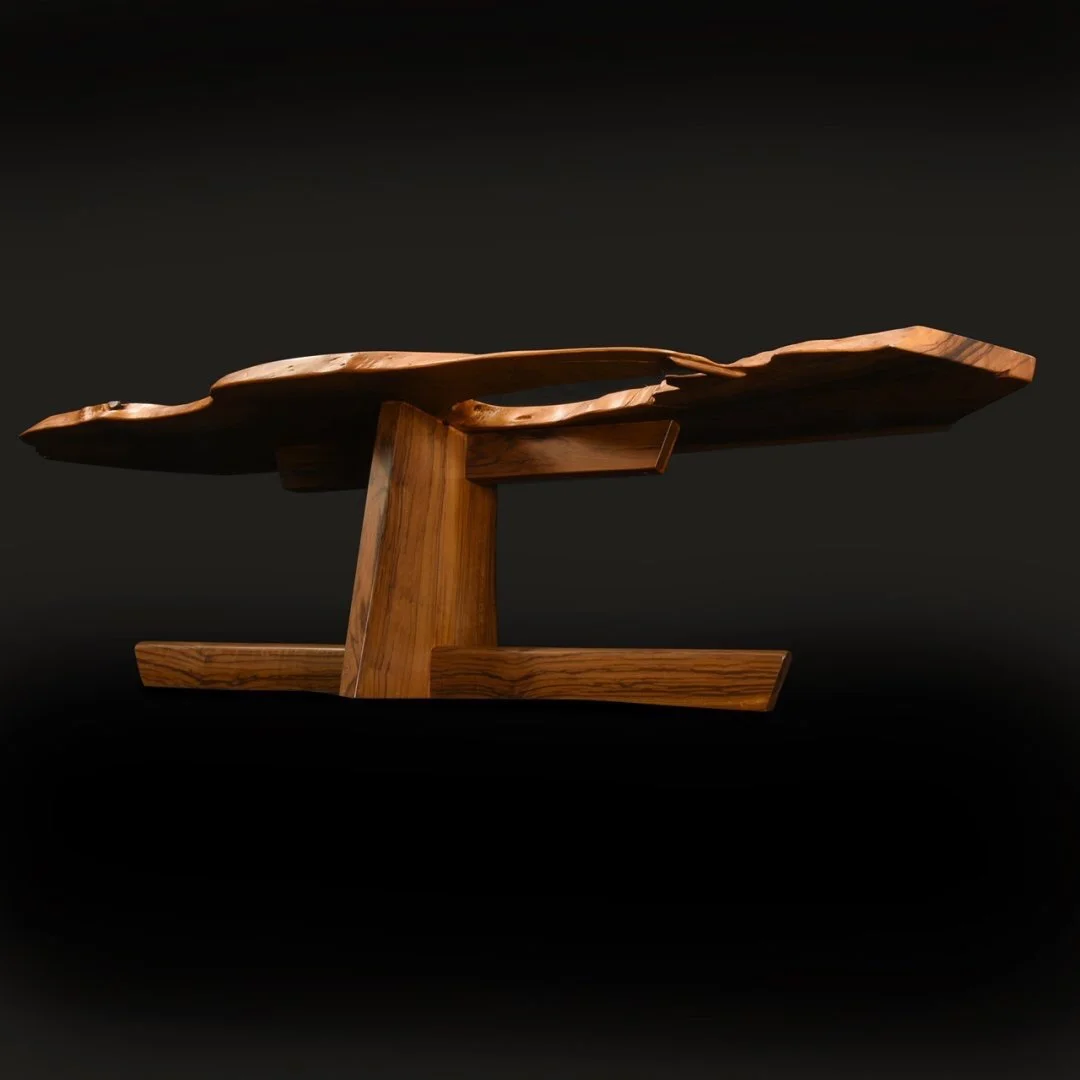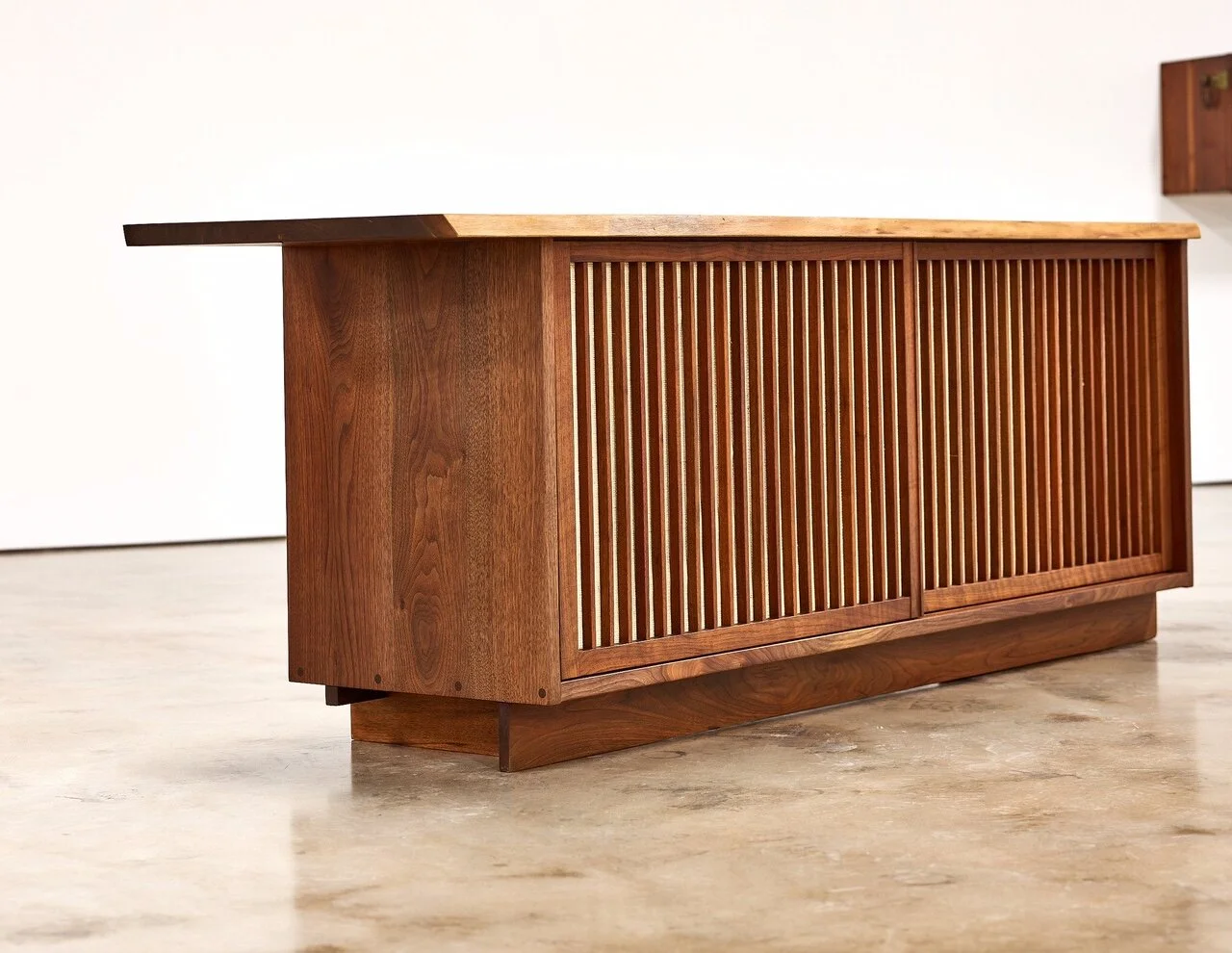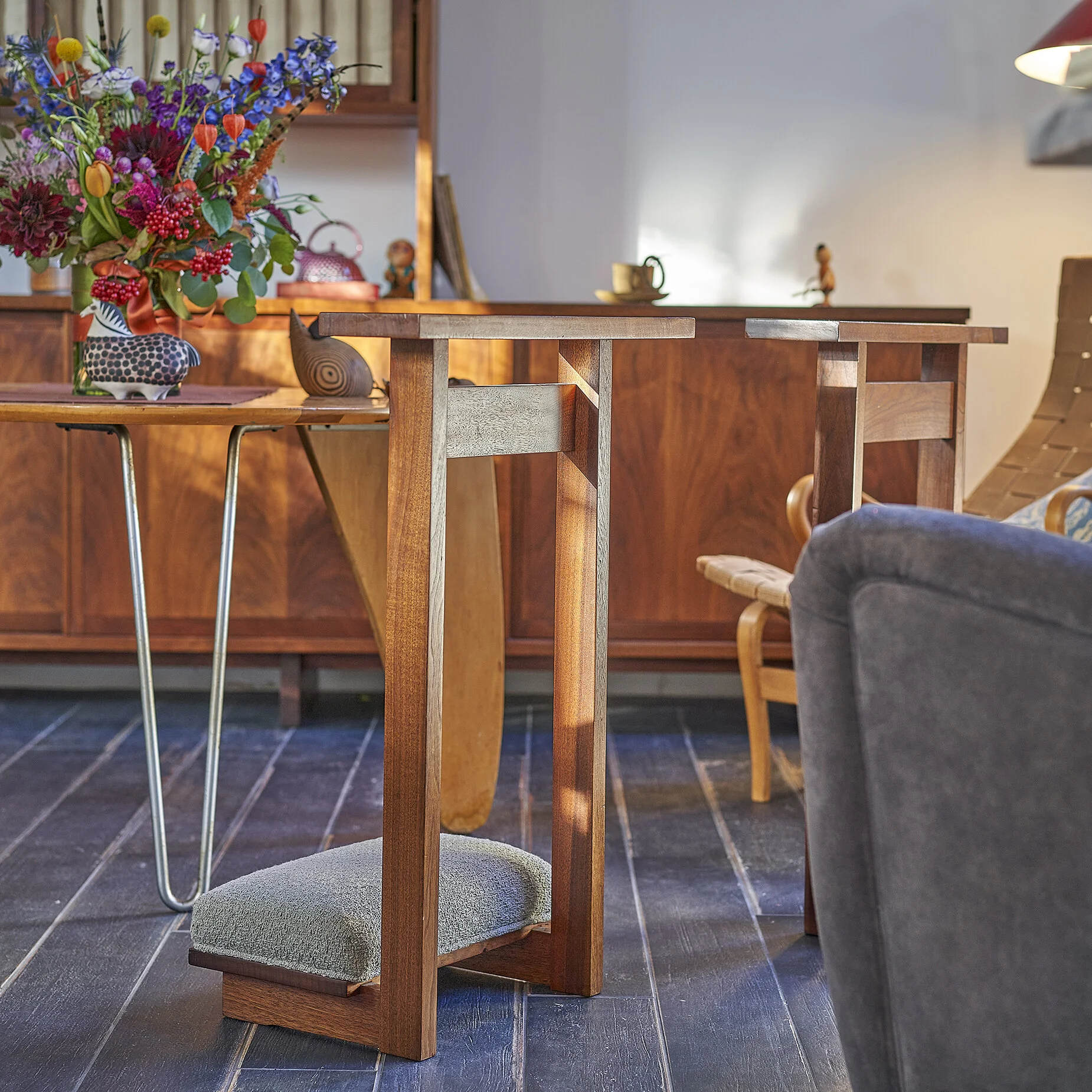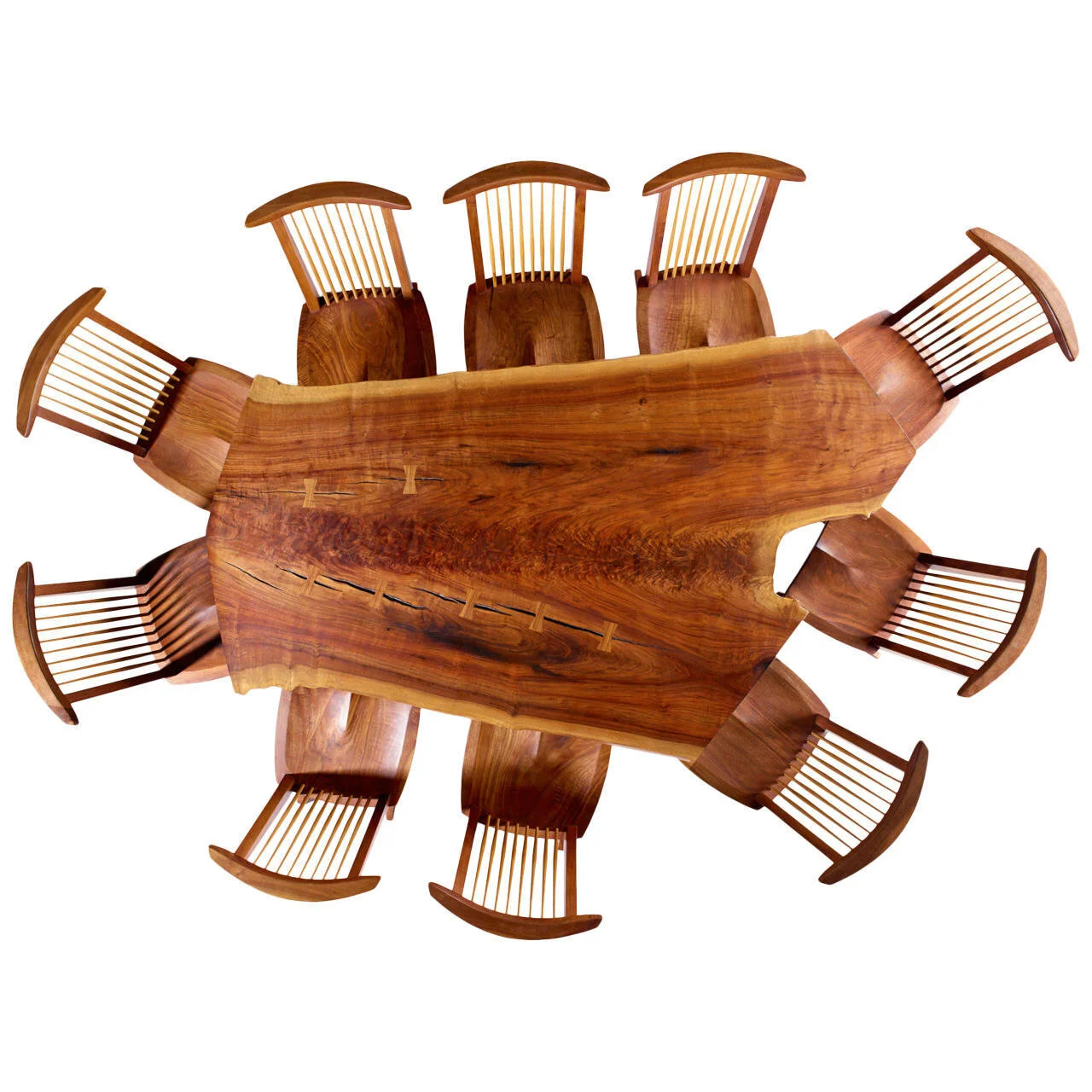George Nakashima
George Nakashima a sacred relationship with trees
The esteemed American poet Ralph Waldo Emerson once wrote In the woods we return to reason and faith One of the most revered names in the American craft movement George Nakashima, must have felt a certain kinship to Emerson's musing. Though most known for his elegant and thought provoking pieces of furniture, Nakashima is also noted for his fundamental belief and philosophy that every tree deserved a second chance at life. From his childhood days walking by the Hoh River Valley to his last years in his workshop and living space in Pennsylvania, Nakashima had always maintained a sacred relationship with trees that have resulted in some of the finest wood furniture of the twentieth century.
George Nakashima was born in Spokane, Washington in 1905 to parents who recently immigrated from Japan. As a young Eagle Scout, he developed an interest in the great outdoors, which led him to take up forestry and architecture at the University of Washington, as well as further studies in architecture at the Institute of Massachusetts. Coinciding with the Great Depression bringing limited opportunities and work experiences in the United States, he left the country and traveled around France, Japan, and India. As a student in Montparnasse, Nakashima was introduced to the city's incomparable architecture and gained lifelong inspiration from Chartres Cathedral and The Pavillon Suisse, a newly designed building by Le Corbusier that featured a purely geometric structure made from natural materials. He moved to Tokyo in 1934 and worked under the architect Antonin Raymond, wherein he appreciated Raymond's style of fusing traditional Japanese elements with innovative Western practices. He was sent to India in 1939 to design and construct one of the country's first reinforced concrete structures. There, he met guru Sri Aurobindo and became a follower of his spiritual teachings. While he did not convert to Hinduism, his time in India led to his modern spiritual belief, wherein he took different aspects from varying religions and made it his own. This newfound spiritual guidance, a harmonious fusion of traditional Eastern and Western elements, would be evident throughout his legacy. As Mira Nakashima wrote in her book Nature, Form & Spirit: The Life and Legacy of George Nakashima: "Sometimes he called himself a Japanese Druid. He also considered himself a Hindu, a Catholic and a hippie, but above all he thought of himself as an intermediary between heaven and earth, joining hands with nature rather than destroying and dominating her."'
Upon his return to the United States, he was struck by how much he disliked the newly constructed American structures and decided to take a break from architecture. After his marriage to Seattle-born Marion Okijama, he was eager to start a new chapter in his life when the attack on Pearl Harbor unfortunately halted his plans. Like all Japanese-Americans at the time, Nakashima's young family, including his 6-week old daughter Mira, were forcibly interned at a relocation camp in Idaho. Tasked with furnishing their barracks to make the space a more pleasant and livable environment, Nakashima met Gentaro Hikigawa, a skilled Japanese carpenter who taught him the craft of traditional Japanese woodworking. A year later, the Nakashima family was released and decided to rebuild their lives and start anew in the aptly-named town of New Hope, Pennsylvania. With a plot of land and the help of family and friends, Nakashima began to build a house and a workshop for his newfound vocation: woodworking.
Providing for his family and starting a new business with limited funds was not an easy feat, yet it is through these circumstances that Nakashima's signature free-edge style would later emerge. As Mira Nakashima recalled in a documentary Collecting George Nakashima If you ever go to a sawmill, they cut off the outsides of the logs because they're crooked and they have knots and holes and cracks…then they get to the inside part of the log and then they can make nice straight-edge lumber This free edge style comprised of irregular edges that were left unfinished in order to show off the natural beauty and contour of each plank. His earliest works in New Hope, however, rarely used the free-edge technique that would later be synonymous with George Nakashima's design aesthetic. Instead he began creating custom-made pieces for his first clients that were free of ornamentation and focused on simple lines to show off the splendor and organic nature of each grain.
After proceeding to produce furniture lines for large-scale retailers such as Knoll and Widdicomb-Mueller, his name became more established and respected as a maker of fine wood furniture. Affluent couples and individuals seeking something different would travel to his workshop and living space in New Hope for private commissions, but Nakashima was mindful of choosing his clients; his pieces could not be made with just the premise of monetary exchange. He found that having a friendly relationship with each client was vital and instrumental to the development of each final piece. It is to this effect that Nakashima knew each and every one of his clients, and the more he resonated with them, the more likely it was that they were given top picks of Nakashima's best selection of lumbers. And these really were the finest choices: whether they were slabs of wood from his own property and local areas or more exotic varieties of Rosewood or English Oak, Nakashima stored and saved piles of logs in his compound of which some are still around today.
In his memoir The Soul of a Tree: A Master Woodworker's Reflections, Nakashima wrote: "There is drama in the opening of a log to uncover for the first time the beauty in the bole, or trunk, of a tree hidden for centuries, waiting to be given this second life." Influenced by the Japanese belief of wabi-sabi, a traditional concept of finding beauty in imperfections, Nakashima took pleasure in finding an ideal use for every part of the tree. While other woodworkers at the time preferred working with the smooth and straight-edged lumber from the inner parts of a tree, Nakashima revered in seeking through the discarded giant roots and pieces with unwanted large cracks. He had an uncanny ability and an almost psychic connection to the wood, sometimes even meditating with each board to find and determine its fullest potential in its second life. As he told Life Magazine in 1970: "I have always been interested in meditation and mysticism. I think I've always been that kind of seeker. But I am also Japanese enough and pragmatic enough to want to give the spirit physical expression."
From a conceptual image in his head, he would draw his design on paper, then he would make a template on the wood board with chalk and pencil. Instead of hiding the large gaps and other anomalies of the wooden plank, he chose to utilize the butterfly joint. Although the butterfly joint was used by others before him, it became a technique that Nakashima really pioneered throughout his life that it began to be called the Nakashima's joint. The butterfly joint was precisely fitted to hold a deep crack in place and would sometimes be made from a different type of wood, unexpectedly creating a focal design element with stunning contrasts in the varying grains. Nakashima never used veneers or any lacquers as the final touch, instead opting to finish each piece with oil to highlight the natural grain of the wood.
Nakashima's most popular pieces range from the sought-after version of the Conoid chair modeled after the flat and curved roof of its eponymous studio, to his highly-regarded free-edge Minguren coffee tables. Yet some of his most celebrated pieces include the large-scale ones commissioned by the late Nelson Rockefeller for his estate in New York during 1973. Considered one of the largest and most important private commissions Nakashima undertook, the lot comprised of over two hundred custom-made pieces. These are most impressive due to their large-scale structures that needed to be proportional to the estate's remarkable size. Another notable commission was for the International Paper Company in 1980, wherein he was tasked to furnish their main headquarters in Manhattan. One-of-a-kind pieces on a scale that pushed his creative boundaries included one of the grandest cabinets he had ever made, as well as very rare pieces incorporating the asa-no-ha pattern, a traditional motif with overlapping hemp leaves that were usually found in sliding screens in wealthy Japanese homes.
In Nakashima's eyes, the tree was always where everything began and it was up to the tree to dictate the form to follow. He merely believed himself to be a skilled woodworker who was able to shape each piece of wood and fashion it into a useful object for human consumption. Perhaps this is why he was often hesitant to put a signature on each of his designs, though some of his later pieces included his signature in black India Ink. Perhaps his reluctance in marking each piece as his own was a sign of respect to the tree; he wanted to let the wood tell its own story and speak for itself. In his essay ‘Meditations on trees and the life of the spirit,' he pondered: "But to leave a piece of wood alone, simply for its own value, is rather Japanese. In Japan, there is a reverence for wood and gentleness towards nature that we don't have here in the West." This recollection of his to Life Magazine further attests to his diverse background of traditional Japanese elements, Western architecture, and mixed spiritual beliefs.
George Nakashima always wanted to be an architect but instead became one of the most successful and renowned woodworkers in the history of American design. Yet he was also an artist, a designer, a father, a husband, and as he declared in an interview in 1985 with National Geographic: "[the] world's original hippie." He believed in world peace and humanitarianism through great design and made that into a reality through the Nakashima Foundation for Peace. In 1984, he was able to purchase a massive 300-year old American Black Walnut log of utmost quality and beauty. A dream that came to him one night led to his vision of using the tree as multiple altars in each continent of the world to unite and bring people together. The first altar site was placed at the Cathedral of St. John the Divine during New Year's Eve in 1986 and was constructed from two of the Black Walnut slabs, ultimately becoming the only alter piece that Nakashima produced in his lifetime.
After George Nakashima's passing in 1990, two more altars were placed in the Russian Academy of Art in 1995 and then at the Auroville Hall of Peace in India. Mira Nakashima took over as the Creative Director of Nakashima Woodworkers and is currently at the helm of her father's business, creating her own designs and pieces that pay tribute to his legacy. She also built the Nakashima Reading Room at the Michener Museum in 1993, a permanent installation that allowed access to her father's timeless furniture and is still used to this day.
George Nakashima's life was full of extraordinary features and ever-present cracks. Like a wood's grain, his life path was often smooth yet full of contrasts, from his beginnings as a Japanese-American with ancestry dating back to Japanese samurais to his transition from an architect to a woodworker. He was at once vehemently opposed to mass production, yet at the same time welcoming new technology and machines. He was against self-marketing and any form of advertising, sticking to his emphasis on creating useful furniture that would turn a dead or dying piece of wood into a fine piece of furniture. Yet after his death, Nakashima's popularity and provenance gradually increased, with the value of his pieces growing exponentially in the last decade.
It can be difficult to imagine a piece of furniture that can look just as home in a modern beach house in Malibu as it can in a private estate in the Catskills, and that's where the genius of a Nakashima piece lies in. A coffee table or a writing desk that is at once attention-grabbing yet harmonious in any space or environment? That's something that only a George Nakashima piece can achieve.








